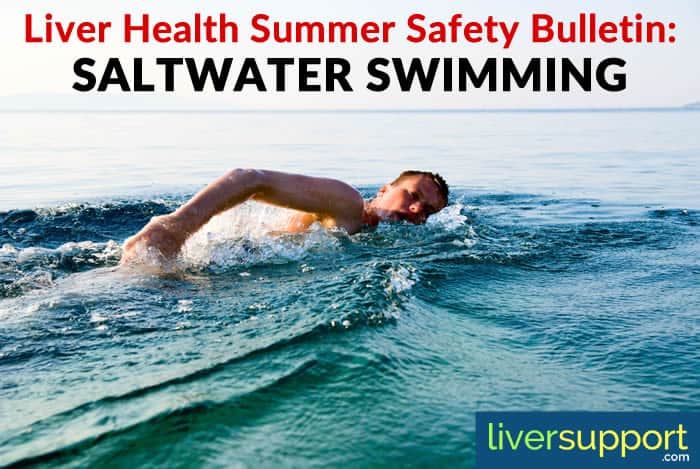
Previous
3 Imperative Rules to Maintain the Health of Your Liver

Next
10 Medications to Be Wary of With Liver Disease
Liver Health Summer Safety Bulletin: Saltwater Swimming
If you have chronic liver disease, consider any open wounds as a warning to delay your ocean swim until it is healed.
Salt is an amazing compound, and has been used to heal the human body for centuries. Because saltwater is antimicrobial and helps draw infectious agents out of tissue, it has many medical applications. Saline (saltwater) is used to clean wounds and heal scrapes, cuts, mouth sores, tooth pain, muscle aches and much more. As such, many can’t wait to swim in the sea’s so-called “healing powers.”
However, ocean or gulf water swimming does not always result in a positive, healing outcome. Especially for those with some type of liver ailment, make sure you are informed about safe saltwater swimming.
Saltwater
When it comes to its healing capability, not all saltwater is created equally. The concentration of salt in sterile saline is typically .9%. On the other hand, seawater usually has a much higher salt content – averaging about 3.5%. The greater concentration of salt in seawater can perform muscle and wound-healing miracles.
However, that is not always the case because seawater is not sterile. At any given point there can be chemicals, bacteria and other pollutants in seawater.
Some beach areas regularly test the water for sewage and bacteria – and are fastidious about alerting swimmers of water pollution. These efforts are commendable, and likely save many people from swimming in contaminated water and suffering the consequences. Even so, there is always some level of contaminants in seawater due to its continual undulation.
In general, individuals who are healthy and have their skin intact are not in danger of acquiring an infection by swimming in seawater. On the other hand, swimming in the ocean with an open wound provides direct access for pathogens to enter the bloodstream. When someone with an open wound has chronic liver disease, the risk of acquiring an infection is magnified.
V. Vulnificus

One pathogen that is particularly harmful to those with liver disease and is frequently found in saltwater in the summer months is Vibrio Vulnificus.
V. Vulnificus is a bacterial microorganism that belongs to the same family as cholera. It is halophilic, which means it requires salt to survive and grow. It also needs warmer temperatures to thrive – which is why infections with this bacteria are more common in the summertime.
If V. Vulnificus finds its way into the bloodstream in those with a compromised liver, the consequences can be dire.
V. Vulnificus infection is characterized by:
- Fever
- Chills
- Dangerously low blood pressure
- Blistering skin lesions
- Occasionally, death
Open Wound
Assuming your ocean swim does not involve drinking saltwater, V. Vulnificus rarely presents a hazard – unless there is an open wound for the bacteria to enter. Interestingly, many people do not realize all of the situations that qualify as an open wound. Open wounds definitely include the obvious, such as a large, bleeding gash.
But an open wound is any break in the skin, which can be a:
- relatively new tattoo that has not fully healed
- relatively new piercing that has not fully healed
- bug bite that was scratched open
- paper cut
- hangnail
- patch of eczema where the skin is broken
- dry, cracked knuckle
If V. Vulnificus gains entrance to the bloodstream via an open wound, immediate medical attention is mandatory. Antibiotics may be helpful if administered quickly, but people with a V. Vulnificus infection can get seriously ill and need intensive care or limb amputation. About 25% with a vibrio bloodstream infection die, sometimes within a day or two of becoming ill.
In people with a healthy immune system, V. Vulnificus from open wound exposure may cause swelling, redness and pain near the wound. Symptoms typically begin one to three days after exposure. However, those who are immunosuppressed or who have chronic liver disease may progress to necrotizing fasciitis, where the bacterium destroys the skin and tissue covering the muscle.
There have been a handful of tragic stories describing an unsuspecting person going for a swim in the sea that eventually proved fatal. The latest incidence was reported May 2017 in BMJ Case Reports, where a 31-year old man with a recent tattoo went for a swim in the Gulf of Mexico. Unfortunately, this man had chronic liver disease, and that swim was his last.
Conclusion
If you have chronic liver disease, think twice before grabbing a boogie board and running into the salty surf.
If you have anything that qualifies as an open wound, carefully and thoroughly cover it for some protection against becoming infected with seawater’s contaminants. Even if utilizing a waterproof bandage, it may be near impossible to prevent that wound from getting wet.
If you get a scrape or cut while swimming, clean the wound immediately and seek medical help right away.
If you already have an open wound, your safest bet is to stay out of that salty natural body of water, because any V. Vulnificus lurking about has the potential to be lethal.
http://casereports.bmj.com/content/2017/bcr-2017-220199.abstract, Vibrio vulnificus septic shock due to a contaminated tattoo, N. Hendren, et al, Retrieved June 11, 2017, BMJ Case Reports, May 2017.
http://www.abc.net.au/health/talkinghealth/factbuster/stories/2010/03/18/2849271.htm, Will Sea Water Help Heal Sores?, Professor Bart Currie, Retrieved June 11, 2017, ABC Health and Well Being, 2017.
https://www.cdc.gov/vibrio/, Vibrio Species Causing Vibriosis, Retrieved June 11, 2017, US Centers for Disease Control and Prevention, 2017.
http://www.distractify.com/omg/2017/06/04/ZDR3RF/died-swimming-new-tattoo, A Man Just Died From Going Swimming After Getting A New Tattoo, Erica Diaz, Retrieved June 11, 2017, Distractify, Inc., 2017.
http://www.newsweek.com/what-vibrio-vulnificus-and-should-you-be-concerned-347673, What is Vibrio Vulnificus and Should You Be Concerned?, Jessica Firger, Retrieved June 11, 2017, Newsweek, LLC, 2017.
https://www.thescientificparent.org/the-water-borne-vibrio-vulnificus-bacteria-what-are-the-risks/, The Water-borne Vibrio vulnificus Bacteria: What Are the Risks?, Dr. Tara C. Smith, Retrieved June 11, 2017, TheScientificParent.org, 2017.










